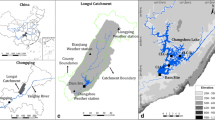Abstract
Based upon the analysis of137Cs and grain-size parameters, the total amounts of137Cs deposition by wind and water in the Dalian Lake of Gonghe Basin, Qinghai Province are defined. The vertical profile of Cs in the lacustrine sediments exhibits three137Cs activity maxima and one minimum. The major maximum corresponds to the global137Cs fallout in 1963; the two secondary maxima correspond to the leakage of the Chernobyl reactor in 1986 and complete desiccation of the lake in 1994, respectively. The minimum corresponds to aeolian deposition caused by extensive reclamation in the late 1980s and early 1990s. The137Cs data set was used to evaluate average sedimentation rate of the Dalian Lake since 1963. The deposition was stable in 1963–1986 and 1994–1998, and it was rapid during 1986–1994. This preliminary study reveals that137Cs has the same potential to trace environmental changes introduce by human interference in arid/semiarid regions as in humid regions.
Similar content being viewed by others
References
Ritchie, J. C., Spraberry, J. A., McHenry, J. R., Estimating soil erosion from the redistribution of fallout Cs-137. Soil Science Society of America Proceedings, 1974, 38: 137.
Rogowski, A. S., Tamura, T., Movement of cesium-137 by runoff, erosion and infiltration on the alluvial Captina silt loam. Health Physics, 1965, 11: 1333.
Ritchie, J. C., McHenry, J. R., Application of radioactive fallout caesium-137 for measuring soil erosion and sediment accumulation rates and patterns: a review, Journal of Environment Quality, 1990, 19: 215.
Wise, S. M., Caesium-137 and lead-210: a review of the techniques and some applications in geomorphology, in Timescales in geomorphology (eds. Cullingford, R. A., Davidson, D. A., Lewin, J.), Chichester: John Wiley & Sons, 1980, 109.
Sutherland, R. A., Kowalchuk, T., de Jong, E., Cesium-137 estimates of sediment redistribution by wind. Soil Science, 1991, 151: 387.
Chappell, A., The limitations of using137Cs for estimating soil redistribution in semi-arid environments, Geomorphology, 1999, 29: 135
Sutherland, R. A., de Jong, E., Estimation of sediment redistribution within agricultural fields using caesium-137, Crystal Springs, Saskatchewan, Canada. Applied Geography, 1990, 10: 205.
Chappell, A., The spatial variability of net soil flux in the south-west Niger, West Africa. PhD thesis, Department of Geography, University College London, 1995.
Chappell, A., Modelling the spatial variation of precesses in redistribution of soil: digital models and137Cs in the southwest Niger, Geomorphology, 1996, 17: 249.
Harper, R. J., Gilkes, R. J., Evaluation for the137Cs technique for estimating wind erosion losses for some sandy western Australian soils, Australian Journal of Soil Science, 1994, 105: 1369.
Bajracharya, R., Lal, R., Kimble, J. M., Use of radioactive fallout cesium-13 to estimate soil erosion on three farms in west central Ohio, Soil Science, 1998, 163: 133.
Pu, L. J., Bao, H. S., Peng, B. Z. et al., Preliminary study on the potential of using137Cs to estimate soil erosion rates in wind eroded area, China: Case study on the Korla,Xinjiang Autonomous Region, Acta Pedologica Sinca (in Chinese), 1998, 35: 441.
Yan, P., Dong, G. R., Zhang, X. B. et al., Preliminary results of using137Cs to study wind erosion in the Qinghai-Tibet Plateau, Chinese Science Bulletin, 2000, 45(11): 1019.
Gill, T. E., Eolian sediments generated by anthropogenic disturbance of playas: human impacts on the geomorphic system and geomorphic impacts on the human system, Geomorphology, 1996, 17: 207.
Rosen, M. R., The important of ground inplayas: A review ofplaya classifications and the sedimentology and hydrology ofplaya, in Paleoclimate and Basin ofplaya Systems (ed. Rosen, M R.), Geol. Soc. Am. Spec. Pap., 1994, 298: 1.
Xu, S. Y., Xu, D. F., Shi, S. R., The geomorphologic development and environmental evolution in Gonghe Basin, Qinghai Province. Journal of Lanzhou University (Natural Science) (in Chinese), 1984, 20: 146.
Dong, G. R., Gao, S. Y., Jin, J., The desertification and its control in the Gonghe Basin, Qinghai Province (in Chinese), Beijing: Science Press, 1993, 25.
Xu, S. Y., The environmental evolution during the Neozoic Era in the Gonghe Basin, Qinghai Province, in The Geological Environment Evolution in the Late Neozoic Era in the Chadamu Basin, Qinghai Province (in Chinese) (ed. Qinghai Institute of Salt Lakes, CAS), Beijing: Science Press, 1986, 19.
Campbell, B. L., Loughran, R. J., Elliott, G. L., A method for determining sediment budgets using caesium-137, in Sediment Budgets (Proceedings of Porto Alegre Symposium, December 1988) (eds. Bordas, M. P., Walling, D. E.), IAHS Publication 1988, 174: 171.
Walling, D. E., Quine, T. A., Use of Caesium-137 as a Tracer of Erosion and Sedimentation: Handbook for the Application of the caesium-137 technique, Exeter: Department of Geography, University of Exeter, 1993, 15.
Yan, P., Application of the caesium-137 technique on the wind erosion: a case study in Gonghe Basin, Qinghai Province (Abstract of PhD dissertation). Journal of Desert Research (in Chinese), 2000, 20: 102.
Collins, A. L., Walling, D. E., Leeks, G. J. L., Using of the geochemical record preserved in floodplain deposits to reconstruct recent changs in river basin sediment sources. Geomorphology, 1997, 19: 151.
Folk, R. L., Ward, W. C., Brazos River bar: a study in the significance of grain size parameters. Journal of Sedimentary Petrology, 1957, 27: 3.
Wu, Z., Eaolian Geomorphology (in Chinese), Beijing: Science Press, 1987, 266.
Lin, X. Z., Chen, S. J., Water resource and its utilization in Gonghe Basin. Memoirs of Institute of Desert, Academia Sinica, Lanzhou, China (in Chinese), 1994, 4: 201.
Zhang, D. S., Qualitative analysis of influential factors on land desertification in Qinghai Gonghe Basin. Journal of Desert Research (in Chinese), 2000, 20: 59.
Wan, G. J.,137Cs dating by annual distinguish for recent sedimentation: samples from Erhai Lake and Hongfeng Lake. Quaternary Sciences (in Chinese), 1999, 19: 73.
Author information
Authors and Affiliations
Corresponding author
About this article
Cite this article
Yan, P., Dong, G. & Dong, Z. 137Cs tracing of lacustrine sediments in the Dalian Lake, Qinghai Province, China. Chin.Sci.Bull. 46 (Suppl 1), 83–87 (2001). https://doi.org/10.1007/BF03187242
Received:
Issue Date:
DOI: https://doi.org/10.1007/BF03187242




